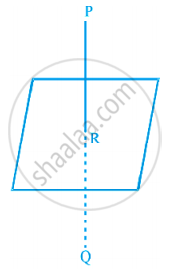Advertisements
Advertisements
Question
Find the image of the point having position vector `hat"i" + 3hat"j" + 4hat"k"` in the plane `hat"r" * (2hat"i" - hat"j" + hat"k") + 3` = 0.
Solution
Let the given point be `"P"(hat"i" + 3hat"j" + 4hat"k")` and Q be the image of P in the plane
`hat"r" * (2hat"i" - hat"j" + hat"k") + 3` = 0 as shown in the figure
Then PQ is the normal to the plane.
Since PQ passes through P and is normal to the given plane
So the equation of PQ is given by `vec"r" = (hat"i" + 3hat"j" + 4hat"k") + lambda(2hat"i" - hat"j" + hat"k")`
Since Q lies on the line PQ
The position vector of Q can be expressed as
`(hat"i" + 3hat"j" + 4hat"k") + lambda(2hat"i" - hat"j" + hat"k")`
i.e., `(1 + 2lambda)hat"i" + (3 - lambda)hat"j" + (4 + lambda)hat"k"`
Since R is the mid point of PQ, the position vector of R is
`([(1 + 2lambda)hat"i" + (3 - lambda)hat"j" + (4 + lambda)hat"k"] + [hat"i" + 3hat"j" + 4hat"k"])/2`
i.e., `(lambda + 1)hat"i" + (3 - lambda/2)hat"j" + (4 + lambda/2)hat"k"`
Again, since R lies on the plane `vec"r" * (2hat"i" - hat"j" + hat"k") + 3` = 0, we have
`{(lambda + 1)hat"i" + (3 - lambda/2)hat"j" + (4 + lambda/2)hat"k"} * (2hat"i" - hat"j" + hat"k") + 3` = 0
⇒ λ = –2
Hence, the position vector of Q is `(hat"i" + 3hat"j" + 4hat"k") -2(2hat"i" - hat"j" + hat"k")`
i.e. `-3hat"i" + 5hat"j" + 2hat"k"`.
APPEARS IN
RELATED QUESTIONS
Find the equation of the plane with intercept 3 on the y-axis and parallel to ZOX plane.
If the coordinates of the points A, B, C, D be (1, 2, 3), (4, 5, 7), (−4, 3, −6) and (2, 9, 2) respectively, then find the angle between the lines AB and CD.
Find the coordinates of the point where the line through (5, 1, 6) and (3, 4, 1) crosses the ZX − plane.
Find the coordinates of the point where the line through (3, −4, −5) and (2, − 3, 1) crosses the plane 2x + y + z = 7).
The planes: 2x − y + 4z = 5 and 5x − 2.5y + 10z = 6 are
(A) Perpendicular
(B) Parallel
(C) intersect y-axis
(C) passes through `(0,0,5/4)`
Find the coordinates of the point where the line through the points (3, - 4, - 5) and (2, - 3, 1), crosses the plane determined by the points (1, 2, 3), (4, 2,- 3) and (0, 4, 3)
Find the equation of the plane passing through the point (2, 3, 1), given that the direction ratios of the normal to the plane are proportional to 5, 3, 2.
If the axes are rectangular and P is the point (2, 3, −1), find the equation of the plane through P at right angles to OP.
Reduce the equation 2x − 3y − 6z = 14 to the normal form and, hence, find the length of the perpendicular from the origin to the plane. Also, find the direction cosines of the normal to the plane.
Write the normal form of the equation of the plane 2x − 3y + 6z + 14 = 0.
Find the equation of a plane which is at a distance of \[3\sqrt{3}\] units from the origin and the normal to which is equally inclined to the coordinate axes.
Find the vector equation of the plane which is at a distance of \[\frac{6}{\sqrt{29}}\] from the origin and its normal vector from the origin is \[2 \hat{i} - 3 \hat{j} + 4 \hat{k} .\] Also, find its Cartesian form.
Find the equation of the plane which contains the line of intersection of the planes \[x + 2y + 3z - 4 = 0 \text { and } 2x + y - z + 5 = 0\] and whose x-intercept is twice its z-intercept.
Write the plane \[\vec{r} \cdot \left( 2 \hat{i} + 3 \hat{j} - 6 \hat{k} \right) = 14\] in normal form.
Write the vector equation of the line passing through the point (1, −2, −3) and normal to the plane \[\vec{r} \cdot \left( 2 \hat{i} + \hat{j} + 2 \hat{k} \right) = 5 .\]
Find the vector equation of a plane which is at a distance of 5 units from the origin and its normal vector is \[2 \hat{i} - 3 \hat{j} + 6 \hat{k} \] .
The equation of the plane containing the two lines
The equation of the plane \[\vec{r} = \hat{i} - \hat{j} + \lambda\left( \hat{i} + \hat{j} + \hat{k} \right) + \mu\left( \hat{i} - 2 \hat{j} + 3 \hat{k} \right)\] in scalar product form is
Find the equation of a plane which is at a distance `3sqrt(3)` units from origin and the normal to which is equally inclined to coordinate axis.
The plane 2x – 3y + 6z – 11 = 0 makes an angle sin–1(α) with x-axis. The value of α is equal to ______.
The unit vector normal to the plane x + 2y +3z – 6 = 0 is `1/sqrt(14)hat"i" + 2/sqrt(14)hat"j" + 3/sqrt(14)hat"k"`.
Find the vector equation of a plane which is at a distance of 7 units from the origin and which is normal to the vector `3hati + 5hatj - 6hatk`
What will be the cartesian equation of the following plane. `vecr * (hati + hatj - hatk)` = 2
